Suzuka International Racing Course
The Suzuka International Racing Course[7] (鈴鹿国際レーシングコース, Suzuka Kokusai Rēsingu Kōsu), more famously known as the Suzuka Circuit (鈴鹿サーキット, Suzuka Sākitto), is a 5.807 km (3.608 mi) long motorsport race track located in Ino, Suzuka City, Mie Prefecture, Japan and operated by Honda Mobilityland, a subsidiary of Honda Motor Co, Ltd. It has a capacity of 155,000.
 | |
| Location | Suzuka, Mie Prefecture, Japan |
|---|---|
| Time zone | UTC+09:00 |
| Coordinates | 34°50′35″N 136°32′26″E |
| Capacity | 155,000 |
| FIA Grade | 1 |
| Owner | Honda Motor Co., Ltd. |
| Operator | Honda Mobilityland |
| Opened | September 1962 |
| Architect | John Hugenholtz[1][2][3][4] |
| Major events | Current: Formula One Japanese Grand Prix (1987–2006, 2009–2019, 2022–present) FIM EWC Suzuka 8 Hours (1978–2019, 2022–present) GT World Challenge Asia (2017–2019, 2022–present) Super GT (1993, 1995–present) Super Formula (1973–present) Former: Grand Prix motorcycle racing Japanese motorcycle Grand Prix (1987–1998, 2000–2003) WTCR Race of Japan (2011–2014, 2018–2019) Suzuka 10 Hours (1966–1973, 1980–2019) FIA GT (1997–1998) NASCAR Thunder Special Suzuka (1996–1997) World Sportscar Championship (1989–1992) |
| Website | www.suzukacircuit.jp |
| Grand Prix Circuit (2009–present) | |
| Length | 5.807 km (3.608 miles) |
| Turns | 18 |
| Race lap record | 1:30.983 ( |
| Motorcycle Grand Prix Circuit (2004–present) | |
| Length | 5.821 km (3.618 miles) |
| Turns | 17 |
| Race lap record | 2:04.387 ( |
| Grand Prix Circuit (2003–2008) | |
| Length | 5.821 km (3.608 miles) |
| Turns | 18 |
| Race lap record | 1:31.540 ( |
| East Circuit (1983–present)[5] | |
| Length | 2.243 km (1.394 miles) |
| Turns | 7 |
| Race lap record | 0:48.245 ( |
| West Circuit (2009–present)[6] | |
| Length | 3.466 km (2.154 miles) |
| Turns | 9 |
| Motorcycle Grand Prix Circuit (2003) | |
| Length | 5.824 km (3.619 miles) |
| Turns | 17 |
| Race lap record | 2:04.970 ( |
| Grand Prix Circuit (1987–2002) | |
| Length | 5.860 km (3.641 miles) |
| Turns | 18 |
| Race lap record | 1:36.125 ( |
| West Shortcut Circuit (1987–2002)[5][6] | |
| Length | 2.780 km (1.728 miles) |
| Turns | 9 |
| Race lap record | 0:58.396 ( |
| Grand Prix Circuit (1983–1986) | |
| Length | 5.945 km (3.694 miles) |
| Turns | 17 |
| Race lap record | 1:54.400 ( |
| Original Circuit (1962–1982) | |
| Length | 6.004 km (3.728 miles) |
| Turns | 17 |
| Race lap record | 1:52.990 ( |
Introduction
.jpg.webp)
Soichiro Honda decided to develop a new permanent circuit in Mie prefecture in the late 1950s. Designed as a Honda test track in 1962 by Dutchman John "Hans" Hugenholtz, the most iconic feature of the track is its "figure eight" layout, with the 1.2 km (0.75 mi) long back straight passing over the front section by means of an overpass. It is one of only two FIA Grade 1 licensed tracks to have a "figure eight" layout, the other one being the Fiorano Circuit.
The circuit has been modified at least eight times:
In 1983 a chicane was inserted at the last curve to slow the cars into the pit straight; the original circuit was an incredibly fast track with only one slow corner; without the Casio chicane some cars would go through the final long right-hand corner flat out and then would go past the pits at more than 200 mph (320 km/h). In 1984 the first part of Spoon was made slightly slower and the corner was brought closer to the track to expand run-off area there, and in 1985 the first corner was made slightly slower.
In 1987 the circuit was brought up to F1 and Grand Prix motorcycle standards for both Japanese Grand Prixs of their respective championships, the F1 Grand Prix being the first held at Suzuka. The Degner curve was made into two corners instead of one long curve, and more crash barriers, more run-off areas were added, exposed vegetation was barricaded off and straw bales were removed (but still used for the Japanese motorcycle Grand Prix).
In 2002, the chicane was slightly modified, 130R (marked as 15 on the diagram) was also modified and some of the snake curves were made a bit straighter and faster; additionally, the runoff area at the Dunlop Curve was doubled from 12 metres to 25 metres, and the corner itself was made slightly tighter.
In 2003, the chicane was made slightly faster and closer to the 130R.[8]
Following the death of Daijiro Kato at the 2003 Japanese motorcycle Grand Prix, Suzuka reconfigured the motorcycle variant of what is now known as the Hitachi Automotive Systems Chicane before the final turn, and added a second chicane, between the hairpin and 200R.[9]
The circuit can be used in five configurations; the car full circuit, the motorcycle full circuit, the "Suzuka east," "Suzuka west car," and "Suzuka west motorcycle" configurations. The "east" portion of the course consists of the pit straight to the first half of the Dunlop curve (turn seven), before leading back to the pit straight via a tight right-hander. The "west" course is made up of the other part of the full circuit, including the crossover bridge; the straight leading to the overpass is used for the start/finish line and the grid. The chicane between the hairpin and 200R separates the west and full course sections between cars and motorcycles.
The Degner curve was named in honour of Ernst Degner after he crashed his factory Suzuki 50 there during Suzuka's inaugural All Japan Championship Road Race meeting on 3 November 1962.
The hairpin (turn 11) was coined 'Kobayashi Corner' after Japanese driver Kamui Kobayashi passed five drivers with aggressive moves at the 2010 Japanese Grand Prix.
At the 2014 Japanese Grand Prix, F1 driver Jules Bianchi suffered serious injuries after colliding with a recovery vehicle, and died in hospital as a result nine months later. In the wake of the accident, the Dunlop corner was slightly changed and revised in safety standards, and the organisers of the Japanese Grand Prix installed a large crane in place of the tractor that Bianchi hit.[10]
Motorsport events
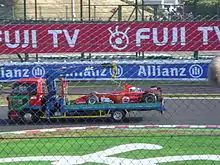
Suzuka, openly touted by F1 drivers and fans as one of the most enjoyed, is also one of the oldest remaining tracks of the Formula One World Championship, and has a long history of races as venue of the Japanese Grand Prix since 1987.[11] Its traditional role as one of the last Grands Prix of the season means numerous world championships have been decided at the track. Four years consecutively in its early history the circuit saw the world championship decided. These include the 1988 championship, which went to Ayrton Senna, the controversial 1989 championship, which went to Alain Prost, and the 1990 and 1991 world championships, which both went to Senna.
Suzuka was dropped from the Formula One calendar for the 2007 and 2008 seasons in favour of the Toyota-owned Fuji Speedway, after the latter underwent a transformation and redesign by circuit designer Hermann Tilke. Suzuka and Fuji were to alternate hosting the Japanese Grand Prix from 2009. However, after Fuji announced in July 2009 that it would no longer be part of the F1 calendar,[12][13] Suzuka signed a deal to host the Japanese Grand Prix in 2009, 2010 and 2011.[14]
The circuit closed for a year for renovations to make it F1-compliant for 2009, with the last major event held on November 18, 2007,[15] although some annual events (for instance, the Suzuka 8 Hours and Suzuka 1000km) were still held. The track held a re-opening day on April 12, 2009.
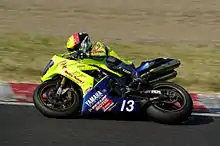
Suzuka also hosts other motorsport events including the Suzuka 1000 km endurance race. Previously a part of multiple GT racing series including the now defunct group C class of the All Japan Sports Prototype Championship, the Suzuka 1000 km as of 2006 is now a points round of the Super GT Series, and is the only race of such length in that series. In 2010, the GT500 pole position time was 1:55.237. In 2007, the GT300 pole position time was 2:06.838.
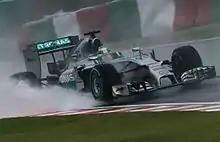
Another major motorsport event is the Suzuka 8 Hours for motorcycles, which has been run since 1978. This event usually attracts big name riders and with the exception of 2005, due to the importance of the major manufacturers' involvement, the FIM ensures that no motorcycle races clash on the date.
NASCAR organized the NASCAR Thunder 100, a pair of exhibition 100-lap races on the east circuit, a 1.4 mi (2.3 km) layout which utilizes the pit straight and esses, before rejoining the main circuit near the Casio triangle. The cars were Sprint Cup Series and Camping World West Series cars and the field was by invitation for the two races, run after the 1996 and 1997 seasons. The 1996 event was marred by tragedy when during practice, pace car driver Elmo Langley died of a heart attack in the Chevrolet Corvette pace car at the esses during an evaluation run. The pole position speed was 83.079 mph (133.703 km/h).[16] During qualifying for the 1997 race, rain caused Goodyear to use rain tires on Winston Cup cars for the first time in the modern era.
It was announced on June 21, 2010, that the east section of the Suzuka Circuit would host the Japan round of the 2011 WTCC season instead of the Okayama International Circuit.[17] At the 2012 event, the pole position time was 52.885 seconds, for an average speed of 94.875 mph (152.687 km/h).[18]
130R corner
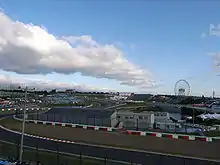
Following two major accidents in 2002 and 2003, one of the main issues in safety has been at the corner 130R (marked 15 in the track map above). In 2002, Toyota F1 driver Allan McNish suffered a high-speed crash through the bump, which sent him through a metal fence; he was not seriously injured.
Track officials revised the 130R, redesigning it as a double-apex section, one with an 85 m (93 yd) radius, and then a second featuring a 340 m (370 yd) radius, leading to a much closer Casio triangle (chicane), with the chicane becoming a "bus stop" type for motorcycles.
However, the problem continued for the new revised section. During the 2003 MotoGP Grand Prix of Japan, the track's first major event since the revisions, MotoGP rider Daijiro Kato was killed when he crashed in the new section, on his way to the braking zone for the Casio triangle. MotoGP has not returned to Suzuka since the incident.
Track configurations
 Original Grand Prix Circuit (1962–1982)
Original Grand Prix Circuit (1962–1982).svg.png.webp) Grand Prix Circuit (1987–2002)
Grand Prix Circuit (1987–2002) West Circuit (1987–present)
West Circuit (1987–present)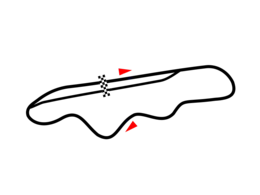 East Circuit (1987–present)
East Circuit (1987–present)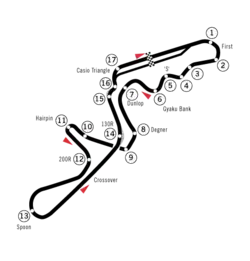 Grand Prix Circuit (2003–2004)
Grand Prix Circuit (2003–2004) Grand Prix Circuit (2003–present)
Grand Prix Circuit (2003–present)
Events
- Current
- March: Super Taikyu
- April: Super Formula Championship, MFJ Superbike
- May: Formula Regional Japanese Championship, TCR Japan Touring Car Series
- June: Super GT, F4 Japanese Championship
- July: GT World Challenge Asia Fanatec Japan Cup, Ferrari Challenge Japan, GT4 Asia Series, Porsche Carrera Cup Asia, Super Formula Lights
- August: FIM Endurance World Championship Suzuka 8 Hours, Super GT, F4 Japanese Championship
- September: Formula One Japanese Grand Prix
- October: Super Formula Championship, MFJ Superbike MFJ Grand Prix, Super Taikyu
- Former
- Asia Road Racing Championship (2013–2019)
- BPR Global GT Series 1000km of Suzuka (1994–1996)
- F3 Asian Championship (2019)
- FIA GT Championship (1997–1998)
- Grand Prix motorcycle racing Japanese motorcycle Grand Prix (1987–1998, 2000–2003)
- IDCR (1978–2003)
- Intercontinental GT Challenge Suzuka 10 Hours (2018–2019)
- International Touring Car Championship (1996)
- NASCAR Thunder Special Suzuka (1996–1997)
- World Sportscar Championship (1989–1992)
- World Touring Car Championship FIA WTCC Race of Japan (2011–2014)
- World Touring Car Cup FIA WTCR Race of Japan (2018–2019)
Lap records
The official lap record for the current circuit layout is 1:30.983, set by Lewis Hamilton during the 2019 Japanese Grand Prix. Previously, the record was set during the 2005 Japanese Grand Prix by Kimi Räikkönen with a time of 1:31.540 (albeit on a marginally longer, slightly different variation of the circuit). The unofficial all-time track record is 1:27.064, set by Sebastian Vettel during the qualifying for the aforementioned 2019 race.[19]
As of July 2023, the fastest official race lap records at the Suzuka Circuit are listed as:[19][20]
In video games

Along with Fuji Speedway, the Suzuka Circuit was one of the four tracks featured in the video game Pole Position II. The track is referred to in the Namco Museum versions of the game as the "Wonder Circuit" ("Orange Circuit" in Namco Museum: Virtual Arcade), after Namco's "Wonder" series of amusement parks, despite its logo appearing on the starter's box since 1983.
The Suzuka Circuit is also featured in the Final Lap series of games which first appeared in 1987. Another Namco racing game, Suzuka 8 Hours, based on the motorcycle race of the same name was released for arcades in 1992, followed by a port for the Super NES in 1993. It can also be seen in arcade games and video games such as Ferrari F355 Challenge, Super Monaco GP, Forza series, Gran Turismo series, RaceRoom, iRacing, R: Racing Evolution, Shift 2 Unleashed, Le Mans 24 Hours, The Cycles, MotoGP 3 of PlayStation 2, MotoGP 4, Tourist Trophy, Auto Modellista, Racing Battle: C1 Grand Prix, Real Racing 3, and as the final race in Taito's racing game Continental Circus. The east course was featured in NASCAR 98. Suzuka's Ferris wheel was paid homage in the "Big Forest Track" in Virtua Racing. A mod for Mario Kart Wii, CTGP Revolution, exists that adds the track.
Project CARS and Project CARS 2 have a Japanese circuit inspired by Suzuka, called Sakitto Circuit. Sakitto has numerous visual differences from the original Suzuka, including the change of position of the Ferris wheel near to Degner curves, as well as the absence of the Casio triangle and the hairpin, a very modified esses section, and a road pass through the real life location of the Ferris wheel.
Deaths
See also
- Twin Ring Motegi, another Honda-owned race track and oval, host to the FIM MotoGP Japanese Grand Prix
Notes
- Both drivers took the same lap time independently in different races.
References
- "日本GPプレビュー (2006 Japanese Grand Prix preview)". Honda. Motor Co., Ltd. (in Japanese). Retrieved 2016-04-16.
- "マイ・ワンダフルサーキット 第28回 (My Wonderful Circuit 28)". Hiroaki Iemura (in Japanese). Honda. Motor Co., Ltd. Retrieved 2016-04-16.
- "マイ・ワンダフルサーキットII 第5回 (My Wonderful Circuit II 5)". Hiroaki Iemura (in Japanese). Stinger. Archived from the original on 2016-06-02. Retrieved 2016-04-16.
- "マイ・ワンダフルサーキットII 第6回 (My Wonderful Circuit II 6)". Hiroaki Iemura (in Japanese). Stinger. Archived from the original on 2016-06-02. Retrieved 2016-04-16.
- "Suzuka Racing Circuit • Details | Motorsport Database".
- "Suzuka Racing Circuits".
- "Japan". formula1.com. Retrieved 29 June 2016.
- "Suzuka: new chicane and 130R". etracksonline.co.uk. e-Tracks. 2 February 2003. Archived from the original on 17 March 2011. Retrieved 21 September 2011.
- "Suzuka Begins Latest Phase of Modifications". motogp.com. Dorna. 2 February 2004. Retrieved 25 July 2015.
- "Suzuka installs larger crane for 2015". GPUpdate.net. Retrieved 27 September 2015.
- "Formula 1 - SUZUKA CIRCUIT". suzukacircuit.jp. Retrieved 2018-10-13.
- "The Official Formula 1 Website". Formula1.com. 2007-09-08. Retrieved 2012-10-06.
- "Fuji gives up F1 race". GPUpdate.net. 7 July 2009. Retrieved 1 February 2011.
- "Suzuka to keep race until 2011". GPUpdate.net. 24 August 2009. Retrieved 1 February 2011.
- Bradley, Charles, ed. (August 2007). "Suzuka to close for a year". Autosport. 189 (6): 11.
- "1996 NASCAR Suzuka Thunder Special - Racing-Reference.info". racing-reference.info. Retrieved 29 June 2016.
- "FIA WTCC TO RACE AT SUZUKA IN 2011". fiawtcc.com. 2010-06-21. Retrieved 2010-07-20.
- Mills, Peter (20 October 2012). "Alain Menu claims pole as Chevrolet seals title". Autosport. Haymarket Publications. Retrieved 20 October 2012.
- "Suzuka Circuit Race Record". 26 April 2023. Retrieved 19 August 2023.
- "Suzuka Fastest Lap Comparison". Archived from the original on 27 February 2023. Retrieved 4 June 2023.
- "2020 Super Formula Suzuka Race 1 Statistics". Retrieved 30 October 2021.
- "2012 Suzuka Formula Nippon". Retrieved 27 February 2023.
- "2022 Super GT Round 3 Suzuka GT500 Results". Retrieved 29 May 2022.
- "全日本スーパーフォーミュラ・ライツ選手権 第12戦 決勝 結果 | Suzuka | 2020年 SFL シリーズカレンダー | superformula lights". superformula-lights.com. Retrieved 13 June 2021.
- "2017 Suzuka Japanese F3 - Round 4". Retrieved 20 May 2022.
- "2021 Suzuka Formula Regional Race 12 Results" (PDF). 12 December 2021. Retrieved 12 December 2021.
- "2018 Super GT Round 3 Suzuka GT300 Results". Retrieved 13 March 2021.
- "2019 Intercontinental GT Challenge Suzuka 10 Hours Race - Driver Statistics" (PDF). 25 August 2019. Retrieved 17 July 2022.
- "Lamborghini Super Trofeo Asia Rounds 5&6 Suzuka International Circuit 28 June-1 July 2018 >> Race 1 - Sector Analysis" (PDF). 1 July 2018. Retrieved 2 January 2023.
- "Porsche Carrera Cup Japan 2023 Final Result Round 5". 3 June 2023. Retrieved 6 August 2023.
- "300 km Suzuka 2009". Retrieved 21 January 2023.
- "Toyota's Hibiki Taira takes strange Japanese F4 double win at Suzuka". Formula Scout. 24 October 2020. Retrieved 20 May 2022.
- "WTCC 2014 » Suzuka Grand Prix Round 22 Results". Retrieved 16 December 2022.
- "2023 Ferrari Challenge Trofeo Pirelli Japan Suzuka Race 1 - Classification - Final" (PDF). 15 July 2023. Retrieved 15 July 2023.
- "2020 TCR Japan Suzuka Round 5 Sunday Race 1 Results" (PDF). 4 December 2020. Retrieved 7 August 2021.
- "2022 Fanatec GT World Challenge Asia Powered by AWS Suzuka Race 2 - Statistics Class: GT4-AM Fastest Lap History" (PDF). 17 July 2022. Retrieved 17 July 2022.
- "2019 MFJ All Japan Road Race Championship Series Round 2 JSB1000 Race 1 Final Official Results". 20 April 2019. Retrieved 20 August 2023.
- "FIM EWC Suzuka 8 Hours 2021 Info". Retrieved 18 March 2021.
- "2020 52nd MFJ Grand Prix ST600 - Race Result" (PDF). 1 November 2020. Retrieved 20 August 2023.
- "2022 54th MFJ Grand Prix J-GP3 - Race Result" (PDF). 6 November 2022. Retrieved 20 August 2023.
- "2018 Asia Road Racing Championship Round 3 - Suzuka International Circuit, Japan Asia Production 250cc - Race 1 Official Result" (PDF). 2 June 2018. Retrieved 29 October 2022.
- "2019 Asia Road Racing Championship Round 4 - Suzuka International Circuit, Japan Underbone 150cc - Race 1 Result" (PDF). 29 June 2019. Retrieved 29 October 2022.
- "2008 Suzuka Formula Nippon". Retrieved 20 April 2022.
- "300 kms Suzuka 2007". Retrieved 16 May 2022.
- "2007 Suzuka Japanese F3 - Round 3". Retrieved 20 May 2022.
- "2004 Suzuka Formula Toyota 1". Retrieved 21 January 2023.
- "1999 Suzuka Japanese F3 - Round 10". Retrieved 20 May 2022.
- "2004 Esso Formula Toyota Series Final Game". Retrieved 21 January 2023.
- "WTCR 2019 Suzuka Race 2 Results". 27 October 2019. Retrieved 29 May 2021.
- "Martin in pole position for NASCAR Thunder Special exhibition". Retrieved 21 April 2022.
- "Suzuka Super Bike 200km 2003 R2-1 MFJ All Japan Road Race Championship Series Round 4 Final Results JSB1000". 25 May 2003. Retrieved 20 August 2023.
- "Suzuka Super Bike 200km 2003 R2-1 MFJ All Japan Road Race Championship Series Round 4 Final Results ST600". 25 May 2003. Retrieved 20 August 2023.
- "1995 Suzuka Japanese F3000". Retrieved 20 April 2022.
- "1996 Suzuka Formula Nippon". Retrieved 20 April 2022.
- "Suzuka 430 Kilometres 1991". Retrieved 22 April 2022.
- "Suzuka 1000 Kilometres 2002". Retrieved 16 May 2022.
- "IV Suzuka 1000 Kms". Retrieved 21 January 2023.
- "Suzuka 1000 Kilometres 1993". Retrieved 3 May 2022.
- "Suzuka 1000 Kilometres 1998". Retrieved 20 April 2022.
- "Suzuka 200 Kilometres 1989". Retrieved 16 May 2022.
- "300 km Suzuka 2002". Retrieved 21 January 2023.
- "2002 Suzuka Japanese F3 - Round 3". Retrieved 20 May 2022.
- "Suzuka 1000 Kilometres 1996". Retrieved 20 May 2022.
- "ITC 1996 » Suzuka Grand Prix Round 26 Results". Retrieved 20 May 2022.
- "Suzuka 1000 Kilometres 1995". Retrieved 3 May 2022.
- "JGTC 1997". Retrieved 22 April 2022.
- "Suzuka 1000 Kilometres 2000". Retrieved 21 January 2023.
- "2001 Suzuka Formula Toyota 1". Retrieved 21 January 2023.
- "Suzuka 300 Kilometres 2000". Retrieved 21 January 2023.
- "1991 Suzuka Super Touring Car 500 Km race". Retrieved 20 May 2022.
- "2000 Suzuka Formula Nippon - Round 5". Retrieved 20 April 2022.
- "2001 Suzuka Japanese F3 - Round 11". Retrieved 20 May 2022.
- "1984 JAF Grand Prix". Retrieved 20 April 2022.
- "Suzuka 1000 Kilometres 1986". Retrieved 21 April 2022.
- "The Suzuka 8 Hours: An Intense History". Retrieved 22 April 2022.
- "1980 JAF Grand Prix". Retrieved 20 May 2022.
- "1981 Suzuka Japanese F2 - Round 1". Retrieved 20 May 2022.
- "500 mile Suzuka 1979". Retrieved 30 May 2022.
- "Motorsport Memorial - Fumiyasu Sato". Retrieved 30 May 2022.
- "Suzuka 1000 Kilometres 1982". Retrieved 30 May 2022.
- "The 4th Suzuka 8 Hours Endurance Race 1981 FIM World Endurance Championship Round 5". Archived from the original on 27 September 2021. Retrieved 22 April 2022.
- "300 km Suzuka 1970". Retrieved 30 May 2022.
- "Clubman Suzuka [GT-I] 1965". Retrieved 29 May 2022.